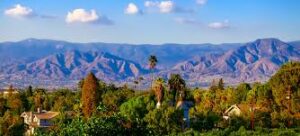
Sometimes the little guy wins. Sometimes “very plain” makes its complex mark. Sometimes literal makes like Odysseus and journeys to a distant metaphor. This is the case with Ruth Bavetta’s poem, “How to Get to My House.” Let’s tackle the poem first:
How to Get to My House
Ruth Bavetta
From Los Angeles, where I was born,
take the San Bernardino Freeway east
past San Gabriel, Glendora, Covina,
up the hill by Forest Lawn,
down into the traffic clumped
where the 210 joins the 10.
Turn on the radio if you like,
there’s quite a way to go.
Pomona, Claremont, Ontario.
Here, if you want,
you can turn off at the airport,
catch a flight to someplace else.
Fontana, Rialto, Bloomington.
You may not have noticed it
but the road has been climbing all the way.
That’s San Bernardino on the left.
You’re in Redlands now,
the climb is a little steeper.
Exit on the Yucaipa offramp.
Just over the bridge,
turn right on Highview.
Stay there through two marriages,
a divorce, a child custody suit,
a brain tumor and a mother
with Alzheimer’s.
Soon you’ll reach where I live.
The pay-off, of course, comes in the final stanza. The first two read like directions your friend might give you in the pre-GPS era. You remember those: when you got lost but were too stubborn to pull over and ask for directions (I’m assuming you’re a male, in this case).
Then, wham. The last five lines of S3. You’ve arrived, all right. But the arrival brings an unexpected welcome. Not a hug, not a cold drink and warm meal, not a guest room, but a surprise. Two marriages. A divorce. A child custody suit.
It gets more alarming: A brain tumor. A mother with Alzheimer’s.
And just when you’re sure you’ve taken a wrong turn and landed at the wrong homestead, the finish: “Soon you’ll reach where I live.”
The poem lulls you with the quotidian. It all seems rather ordinary and list like. As a reader, you never suspect that you are being set up, that there is something surprising around the next curve, something as shocking as an elk standing in the middle of the road.
For an excellent tour guide as you reread this poem, check out Mark Scarbrough’s “Lyric Life” podcast, which occasionally treats on poems famous and not-so-famous.
My hat’s off to Mark for honoring the “not-so-famous” as well as the overly-trodden famous in the world of poetry.
That’s a direction we all should take now and again.